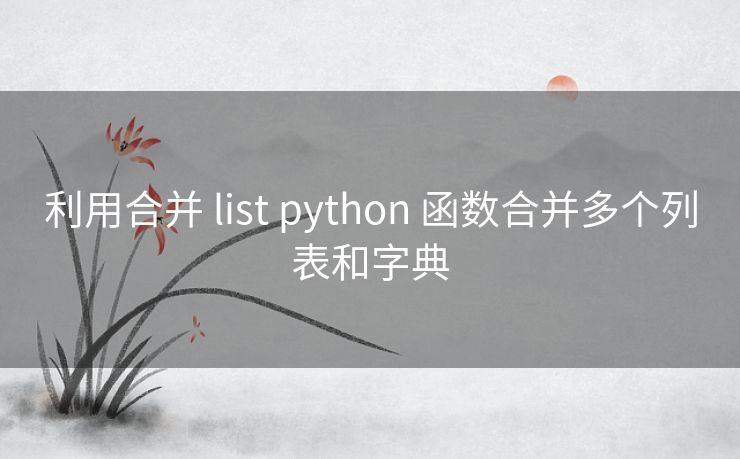Python 作为一种广泛应用于编程领域的编程语言,有许多编程技巧和函数可以用来简化编程过程。其中,合并列表和字典是一种常见的操作,可以使用 Python 提供的内置函数实现。在本文中,我将介绍如何使用 Python 的 `合并` 函数,将多个列表和字典合并为一个列表和字典。
1. 合并多个列表

使用 Python 中的 `+` 运算符可以将两个列表组合成一个新的列表。例如:
```python
list1 = [1, 2, 3]
list2 = [4, 5, 6]
new_list = list1 + list2
print(new_list) # [1, 2, 3, 4, 5, 6]
```
但对于多个列表的情况,`+` 运算符会变得很麻烦。幸运的是, Python 提供了一个内置函数—— `extend` 函数,可以把一个列表跟另一个列表合并。例如:
```python
list1 = [1, 2, 3]
list2 = [4, 5, 6]
list3 = [7, 8, 9]
new_list = []
new_list.extend(list1)
new_list.extend(list2)
new_list.extend(list3)
print(new_list) # [1, 2, 3, 4, 5, 6, 7, 8, 9]
```
这个程序首先创建了一个新列表。接着,它使用 `extend` 函数将 list1、list2、list3 中的元素逐一添加到新列表中。最终,该程序在屏幕上打印出了最终的合并列表。
2. 合并多个字典
合并多个字典跟合并多个列表一样,也需要用到 Python 提供的内置函数。内置函数 `update` 可以用于将一个字典中的所有键值对添加到另一个字典中。例如:
```python
dict1 = {a: 1, b: 2}
dict2 = {c: 3, d: 4}
dict3 = {e: 5, f: 6}
new_dict = {}
new_dict.update(dict1)
new_dict.update(dict2)
new_dict.update(dict3)
print(new_dict) # {a: 1, b: 2, c: 3, d: 4, e: 5, f: 6}
```
这个程序创建了一个新字典。它使用 `update` 函数将 dict1、dict2、dict3 中的键值对逐一添加到新字典中。最终,新字典代表了所有字典中的键值对。
3. 合并列表和字典
当需要将多个列表和字典合并到一个列表和字典中时,我们可以按照上述方法分别进行合并。例如:
```python
list1 = [1, 2, 3]
list2 = [4, 5, 6]
dict1 = {a: 1, b: 2}
dict2 = {c: 3, d: 4}
new_list = []
new_dict = {}
new_list.extend(list1)
new_list.extend(list2)
new_dict.update(dict1)
new_dict.update(dict2)
print(new_list) # [1, 2, 3, 4, 5, 6]
print(new_dict) # {a: 1, b: 2, c: 3, d: 4}
```
这个程序首先创建了一个新的空列表和一个新的空字典。然后,它使用 `extend` 函数将 list1、list2 中的元素逐一添加到新列表中;使用 `update` 函数将 dict1、dict2 中的键值对逐一添加到新字典中。最终,程序在屏幕上打印出最终的合并列表和字典。
4. 使用 `*` 操作符可以更直观地合并列表
从 Python 3.5 开始,可以使用 `*` 操作符对列表进行展开,使多个列表更直观地合并。例如:
```python
list1 = [1, 2, 3]
list2 = [4, 5, 6]
new_list = [*list1, *list2]
print(new_list) # [1, 2, 3, 4, 5, 6]
```
这个程序使用了 `*` 操作符来展开 list1 和 list2,然后用 `+` 运算符将它们合并成一个新列表。这是与 extend() 函数实现相同的结果,但是代码更简洁和 pythonic。
总结
Python 提供了许多用于合并多个列表和字典的内置函数和操作符。合并多个列表时,我们可以使用 `extend` 函数把一个列表跟另一个列表合并;使用 `+` 操作符将两个列表组合成一个新的列表。对于合并多个字典,我们可以使用内置函数 `update` 来将一个字典中的所有键值对添加到另一个字典中。最后,从 Python 3.5 开始,使用 `*` 操作符更简洁或者更 pythonic 。









